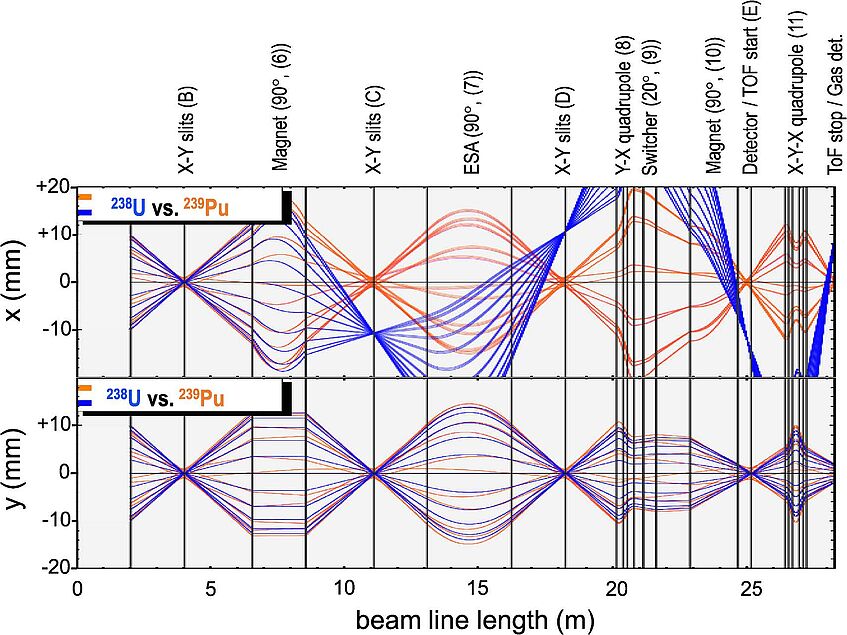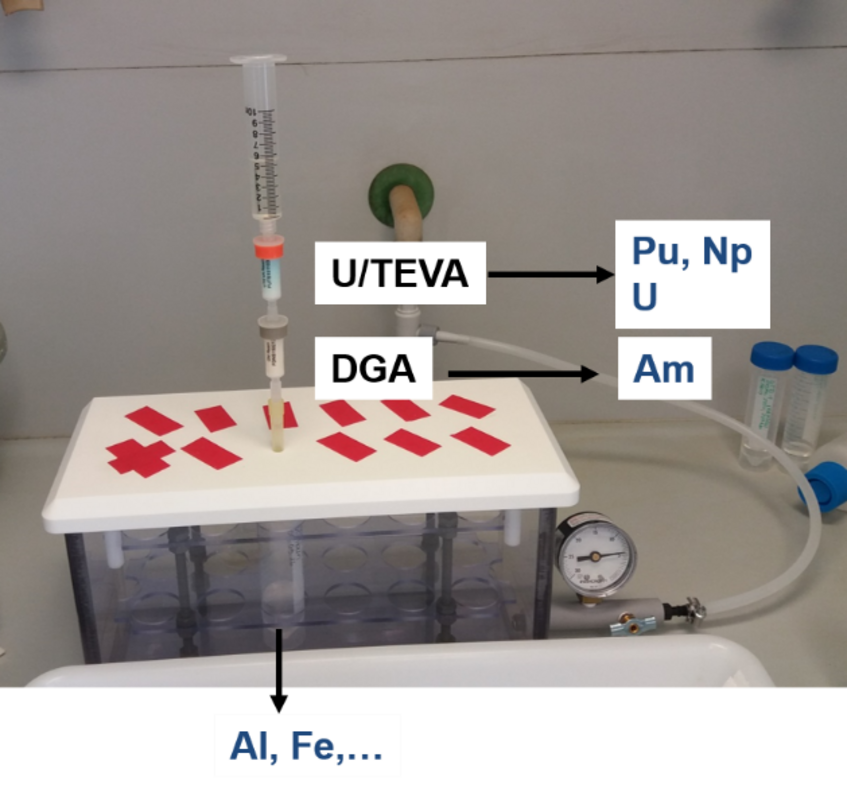Analysis of long-lived Actinides

Transport of 239Pu3+ (red) and 238U3+ (blue) through the analyzer beam line, while the instrument is tuned for mass 239 u.
Analysis of long-lived Actinides
- Long-lived actinides such as 236U, 237Np or 239,240Pu occur naturally in the environment at ultra-trace level (236U/238U ~ 3×10-14) and are produced primarily by neutron capture on the primordial nuclides 232Th or 235,238U. Since the beginning of the “nuclear age” in the 1940s, the environmental abundance of these nuclides has significantly increased due to anthropogenic sources including nuclear reactor accidents, reprocessing plants or fallout from nuclear weapons testings. Whereas the releases from the two sources named first may be radiologically relevant but usually locally restricted, the debris from the nuclear weapons has been spread virtually around the globe as so-called global fallout superimposing the natural level of these radionuclides. Due to the long half-life and the heavy dilution in the atmosphere, global fallout is characterized by a low specific activity (e.g. 239+240Pu ~ 1 mBq/g(soil), 0.05 mBq/kg(ocean water)) and therefore is generally considered as radiologically not relevant.
- Although the chemical properties of the mentioned elements were extensively studied, there are big gaps of knowledge concerning their behavior in the environment. The analysis of the distribution of anthropogenic actinides already present in the environment provide the opportunity to improve our understanding of the migration pathways of these nuclides to predict local accumulations (e.g. in biota) and to assess the risk for human exposure in case of future releases.
- AMS is able to measure long-lived actinide largely background-free due to the lack of stable isobars. VERA not only defines the state of the art for measuring both, natural and anthropogenic actinides but is pushing the boundaries with respect to even smaller sample sizes, shorter measurement duration and expanding the portfolio of AMS to new isotopes. In this tradition VERA has introduced 236U as a new “AMS isotope” which is now largely accepted as ocean tracer. Current work is exploring the application of the isotopic ratio 233U/236U (around 1%) for the identification of releases from nuclear industry. The minimum sample size for actinides is basically defined by the detection efficiency including chemical sample preparation, which, compared to other AMS nuclides, is rather low for actinides (10−5 - 10−4). At VERA we have successfully increased the overall efficiency by around one order of magnitude by several improvements of the setup and the measurement procedure. This either significantly simplifies sample preparation eliminating the need for chemical separation of actinides from each other or it allows the analysis of the complete nuclide vector of 233,236U, 239,240Pu, 241Am, and 237Np from a single sample at ultra-low levels (below 10−3 ppq for 241Am) after chemical separation. Present research is focusing on the increase of the ionization yield in the ion source by extracting actinides as negative fluoride compounds (diploma thesis M. Kern) and on the production and characterization of an isotopic spike for the quantitative detection of 237Np (funded by the FWF).
- Closely linked to the requirements of the detection method, we also develop corresponding chemical sample preparation procedures for various types of sample materials e.g. fresh and sea water, sediments, soil, air filters. These procedures are provided to our clients and training of co-workers and students in our chemistry labs is offered.

